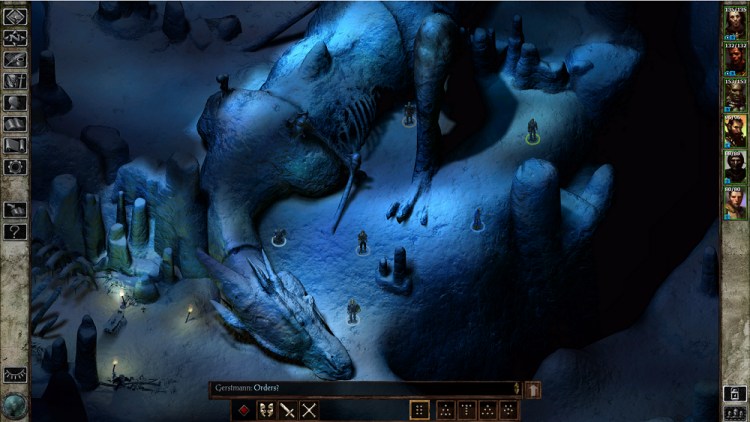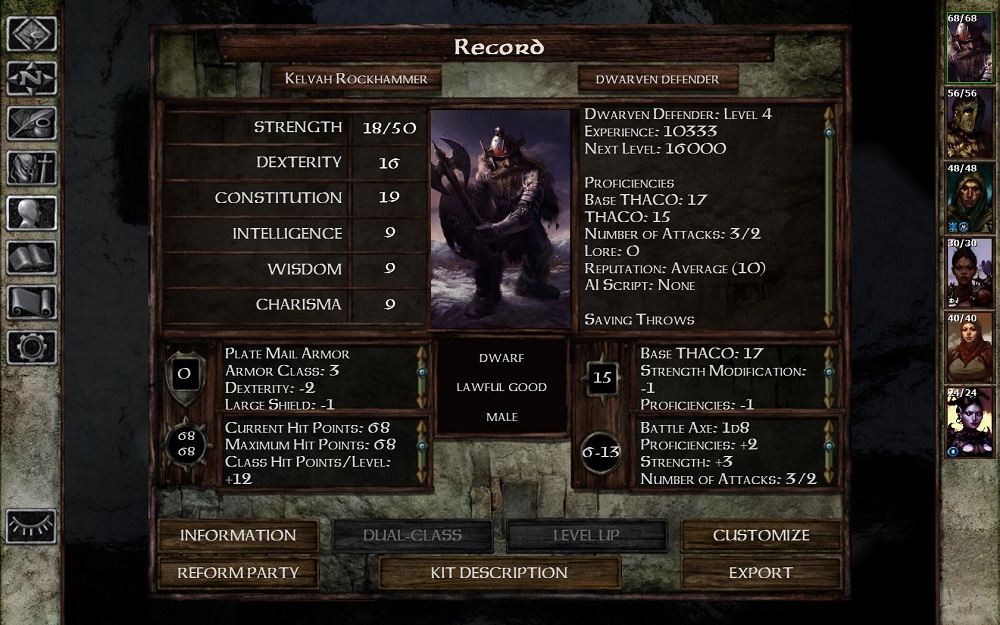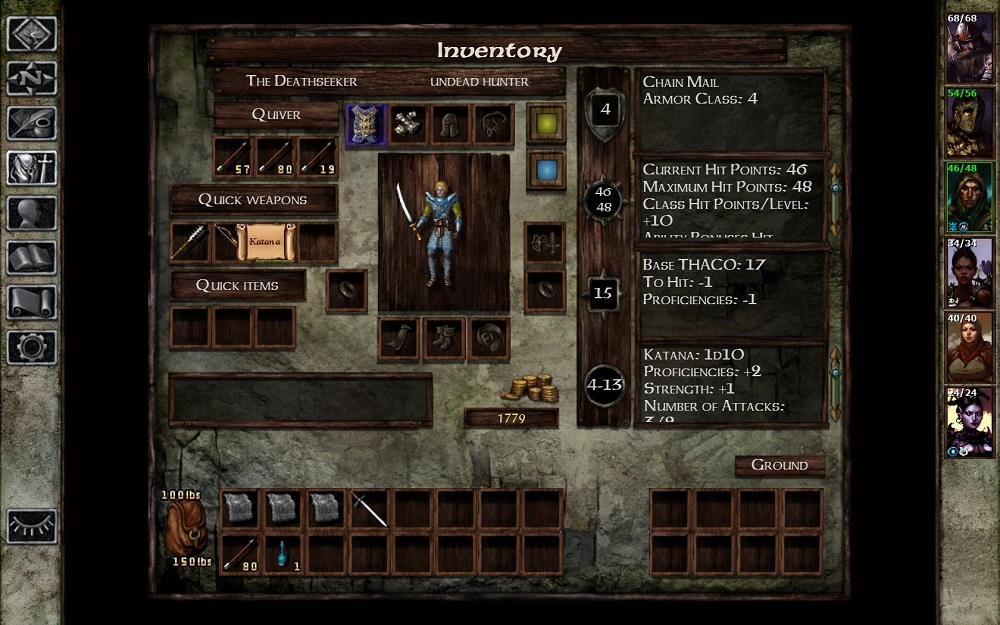GamesBeat: So Icewind Dale: Enhanced Edition got help from a fan.
Oster: Actually, Icewind Dale: Enhanced Edition was mostly done by ex-modders.
GamesBeat: That’s really cool.
Oster: When we were working on Baldur’s Gate: Enhanced Edition, we reached out to the modding community, and we hooked up with a couple guys who’d been modding Baldur’s Gate for the last 10-plus years. They’ve done amazing stuff. They’d done all these fix packs. We were talking to them about, hey, what’s the right way to approach things? We had this idea about how we were going to totally change the file-handling system and we were going to make modding easier. At which point they told us, Jesus, no, don’t do that, you’ll blow up everything we’ve ever done. Don’t go there. We’re like, whoa, OK, we’re stupid. Tell us how to do it. Tell us how you want it. We’ll make sure it works amazingly well.
So we went through and we were able to build a system up that totally fit what they wanted to do and how we wanted to work on things going forward. We wound up hiring a couple of them. And then they said, hey, you should hire this guy, you should hire that guy. At last count there’s a dozen of them.
GamesBeat: I love that.
Oster: That was actually the pipeline for hiring at BioWare after Neverwinter Nights. We shipped Neverwinter, and it’s this great tool set. We’d say, hey, you want a job as a designer at BioWare? Here, build us a Neverwinter mod and show us your chops. It was great from our perspective, because we hired somebody who was a proven entity. They know how to use the tools and do these things. I can think of two cases specifically where guys sent in modules, we sat down and reviewed them, and we were like, this guy’s amazing. I have no idea how he did this. So we hired these guys. One guy was … from Israel. The other guy was Georg Zoller, who was from Germany.
It was David Wallace who helped us on Icewind Dale at the start. He did this massive converter to move all the assets. Everything was different. The graphical formats, text formats, everything got transmogrified just slightly.
GamesBeat: What’s your favorite party makeup when you’re playing Icewind Dale?
Oster: I’m a pretty straight-up guy. I like two tanks, a healer, cleric, and one mage, but I don’t even really call him a mage. He’s my fireball unit. Typically, I’ll have a thief I can use as a scout unit, so I can drop fireballs on ’em. I usually try to give him a ring of fire resistance or something like that, because I occasionally feel bad when my thief bites it because I fireballed him.
GamesBeat: You made some items, spells, and new character kits. Are these things you played with in 3E or 4E D&D games, or just things you came up with from scratch?
Oster: Some of the items are — I think everything comes from somewhere. Some of the items were created to fill a need in the game. There was a void there. Some of them came from personal gameplay sessions, specifically from some of the mod group that joined our team. They really wanted to explore something. They said, hey, I got this idea for this weapon or this plot.
And we had to essentially backfill some content. In the original Icewind Dale, there was kind of a — some of the mod guys created a mod called Unfinished Business. Basically they went in and found content that had been cut and just kind of left there, and they restored some of that content. The great thing here is, when we got the archive of Icewind Dale stuff from [D&D maker] Wizards of the Coast, it actually had a lot of the notes from the designers on what they were trying to do and how they intended plots to go. We were able to dig in to those notes and say, OK, based on that, this story was supposed to go like this. We filled it out and got it working. Here, this is how they planned it. In some cases we were like, that’s too conservative. Let’s make it bigger. We were able to flesh out plots and make things pretty awesome.
GamesBeat: What’s your new favorite weapon that you guys made?
Oster: Ah … that’s a good question. I don’t think I have a specific favorite that I’ve played with yet. I know historically there was no support for katanas in the game, so when you did your total — you couldn’t do your total cheesetastic kensei mage. Whereas now you can do the cheesetastic kensei mage. You can grab magic katanas and go in and suddenly you have this pseudo-killer character that historically you just couldn’t pull off. As well, we have just a really good variety of weapons that weren’t there before. I haven’t hit one that I’m in love with yet.
GamesBeat: What about a new spell you’ve made?
Oster: I was playing a cleric, the Champion of Tempus. They basically have this ability where they can boost themselves up every day. I was buffing myself as I went, trying to explain to Phil that he should stop killing us and getting us murdered by — we did a live gameplay stream where we were playing for the Child’s Play charity. Phil, our lead designer, he managed to keep killing us over and over again. “Phil, don’t open that door!” He would open the door and murder us. I was constantly trying to buff the party, buff myself, anything I could do to survive. It didn’t work well. Phil’s malevolence was much greater than my ability to buff us.
GamesBeat: Would that also be your new favorite kit added to the game?
Oster: Let me think. I think my favorite was the spirit druid. You could summon a spirit bear or a spirit snake. His snake was devastating. It was everywhere, all over the screen. You could barely see it, and all of a sudden it would just pop in and be murdering things. Go, snake! I think the spirit druid, by far.
GamesBeat: How does the co-op work? Do they bring in one character and it’s like, they have one and you have your party of five? Or could you conceivably play with five other people and each of you has one member?
Oster: Yes. So, what you do is — it’s kind of similar in terms of how Baldur’s Gate would play. The person who created the game can go and generate all the characters, or they can open up the slots so that other players can generate the characters. They can allocate out those slots. In the stream we were playing with two of us at some points, three of us at some points. When we were playing with two people, we each took three characters. When we were playing with three of us, we could each take two. You could go up and be playing it so that you’ve got one player playing each character, six players jumping in and having a great time with it. We had a lot of fun playing it on our screen. It was pretty hilarious. Phil was just deliberately thinking about how he could screw us up. He’s like, I’m gonna attack the innocent people! That’ll create some fun! Sure enough, everybody starts attacking us.
GamesBeat: That’s more like a true role-playing experience if you think about it. You could play in an MMO, and if you start attacking people, it doesn’t really do anything.
Oster: Being able to play, especially cross-device, it’s pretty awesome. Early on in testing, I was playing on an iPad. Another guy’s playing on Android. Another guy’s playing on a Mac. It’s all the same data, so it just plays across multiple platforms.
GamesBeat: What is it about Icewind Dale, in your opinion, that keeps people coming back?
Oster: I think it was just an amazing sense of atmosphere in its time. They did the whole frozen north, cold — it just had an environmental presence that other games at the time didn’t have. It’s still true. The artwork is beautiful. You look at the area art — I’m still looking at it going, damn, those guys were good. We got to know a bunch of the guys down at Black Isle while we were working on the Baldur’s Gate stuff. We shared — there was actually a point where I was working as a 3D artist, and some of the guys actually tutored me on how to make better-looking stuff. They were just a really strong art team. They made a beautiful-looking game. With us, we were able to go in and take the stuff that was there and improve it where we could, but in many cases it was just taking the original source and instead of running through this complex process of grinding it all up and paletizing it and putting it into different chunks — our new system basically just works with the raw images and puts them, not straight into the game, but it puts them in the game at a lot higher quality.
VentureBeat's mission is to be a digital town square for technical decision-makers to gain knowledge about transformative enterprise technology and transact. Learn More



